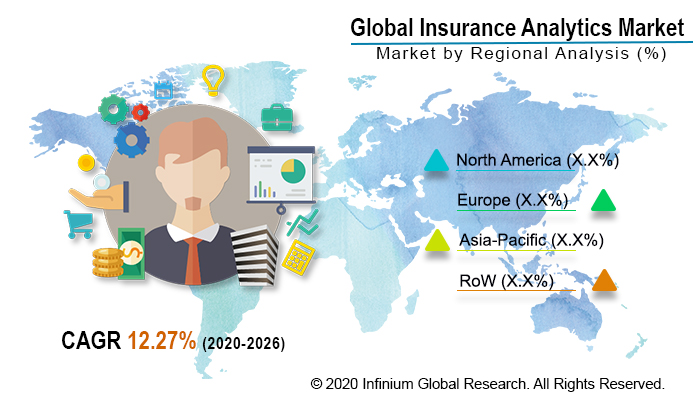Insurance Analytics Market (Component - Tool; Deployment - Cloud, and On-premise; Application - Claim Management, Risk Management, Process Optimization, and Customer Management & Personalization; Enterprise Size - Large Enterprise, and SMEs; End-users - Insurance Companies, Government Agencies, and Third-party Administrators, Brokers, and Consultancies): Global Industry Analysis, Trends, Size, Share and Forecasts to 2026
A recent report published by Infinium Global Research on insurance
analytics market provides an in-depth analysis of segments and sub-segments in the
global as well as regional insurance analytics market. The study also highlights
the impact of drivers, restraints, and macro indicators on the global and
regional insurance analytics market over the short term as well as long term.
The report is a comprehensive presentation of trends, forecasts, and dollar
values of the global insurance analytics market. According to the report, the
global insurance analytics market is projected to grow at a CAGR of 12.27% over
the forecast period of 2020-2026.
Market Insight
Insurance analytics provide tools and services that can be used to
process and analyze data to generate comprehensions, which are helpful in
decision making. The rising competition in the market is encouraging companies
to upgrade their existing business model, streamline operations, and enhance
the procedures. Furthermore, rapidly maturing digital infrastructure and
increasing fraudulent activities in the insurance industry is anticipated to
increase the demand for analytics solutions. In consequence of the changing
financial policies and regulations across the world, the insurance facilities
are compelled to opt for analytics to control their operations.
Insurers are now leveraging analytics solutions to provide
additional policy discounts and preemptive risk management services. Insurers
are now able to understand their customers’ lifestyles and create customized
coverage to match their requirements. For example, if an insurer learns about a
customer’s upcoming travel plans, they can create personalized travel coverage
to take care of their travel insurance. They are now able to send automated
messages to inform drivers in case of adverse weather conditions or major road
repair supporting their clients to take alternative routes providing an
enriching experience. Furthermore, the rapid adoption of data-driven decision
making and the growing adoption of advanced analytics techniques are boosting
the growth of the insurance analytics market. Additionally, higher adoption of
insurance analytics services and tools among the SMEs and the increasing
adoption of IoT insurance are projected to offer lucrative opportunities in
this market. On the other hand, data quality and security issues, and the
dearth of skilled workforce are the factors hindering the growth of the market.
Furthermore, the current concern over the spread of novel coronavirus is also
expected to have a positive and long term impact on the insurance analytics
market. The COVID-19 pandemic highlights the necessity of robust data and
advanced analytics, which can condense the uncertainty during dynamic disease
outbreaks. The leading factors driving the growth of COVID-19 outbreak impact
on the analytics industry comprise increased investments in analytics,
increasing demand for remote services and location data, and growing demand for
digital transformation.
Among the geographies, the North America region is expected to
hold the largest share in the global insurance analytics market owing to the
early adoption of technology advancements and analytics. The United States and
Canada are anticipated to be the major revenue contributors in the North
American insurance analytics market. Most of the insurance analytics vendors,
comprising major players, have a direct or an indirect presence in this region
through distributors and resellers. Furthermore, the Asia Pacific region is
projected to grow at the fastest rate in the global insurance analytics market
during the projection period, owing to its growing technology adoption rate.
Rapid economic developments, globalization, digitalization, and the increased
adoption of cloud-based technologies are anticipated to drive the insurance
analytics market in the Asia Pacific region.

Segment Covered
The report on the global insurance analytics market covers segments
such as component, deployment, application, enterprise size, and end-users. On
the basis of the component, the sub-markets include tool. On the basis of
deployment, the sub-markets include cloud, and on-premise. On the basis of
application, the sub-markets include claim management, risk management, process
optimization, and customer management & personalization. On the basis of
enterprise size, the sub-markets include large enterprise, and SMEs. On the
basis of end-users, the sub-markets include insurance companies, government
agencies, and third-party administrators, brokers, and consultancies.
Companies Profiled:
The report provides profiles of the companies in the market such
as Hexaware Technologies, LexisNexis Risk Solutions, Microsoft Corporation,
MicroStrategy Inc., OpenText, Oracle Corporation, PEGASYSTEMS INC., Sapiens
International, Tableau Software, LLC, and Verisk Analytics, Inc.
Report Highlights:
The report provides deep insights into the demand forecasts,
market trends, and micro and macro indicators. In addition, this report
provides insights into the factors that are driving and restraining the growth
in this market. Moreover, The IGR-Growth Matrix analysis given in the report
brings an insight into the investment areas that existing or new market players
can consider. The report provides insights into the market using analytical
tools such as Porter's five forces analysis and DRO analysis of the insurance
analytics market. Moreover, the study highlights current market trends and
provides forecasts from 2020-2026. We also have highlighted future trends in the
market that will affect the demand during the forecast period. Moreover, the
competitive analysis given in each regional market brings an insight into the
market share of the leading players.
